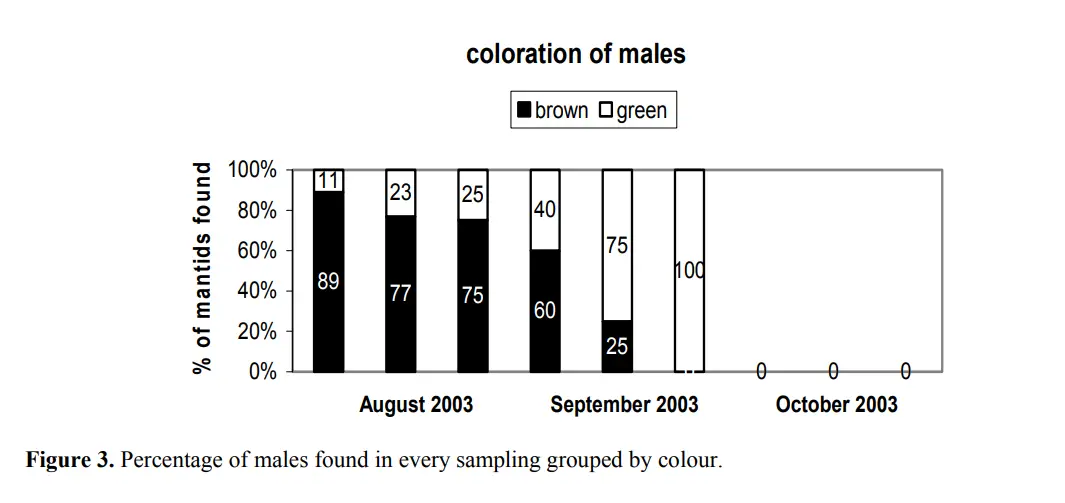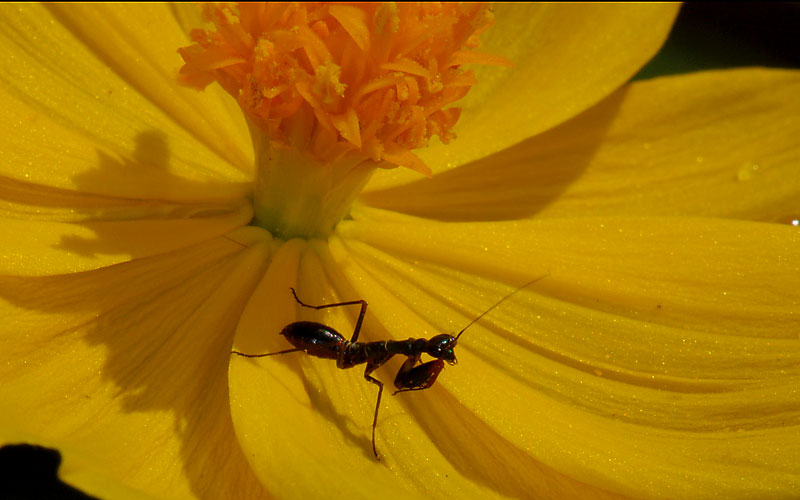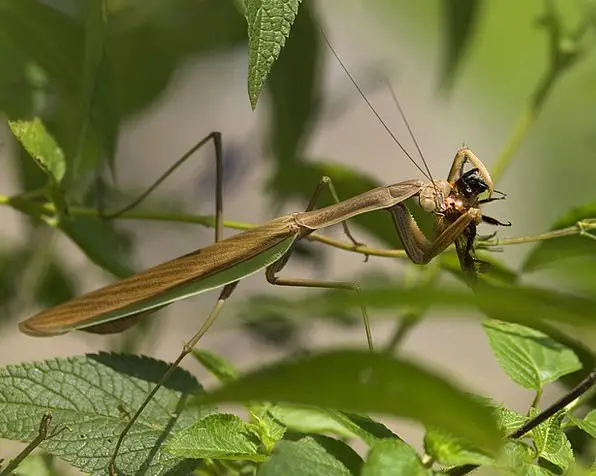YES praying mantis can fly but probably not in a way other flying insects do. They have a clumsy flight and they can’t fly longer distances. Mantises are more of a jumping insect rather than flying. In fact, many mantises just can’t fly. In flying mantises, only males know how to fly. Females do possess wings but they just can’t take the flight. Perhaps you might like to know as to how do praying mantis fly.
Can Praying Mantis Fly in the Wild? – How Do Praying Mantis Fly?
Unlike adults, young mantises do not know how to fly for they don’t have wings; they just leap from point A to point B. However, the leaping ability of an immature praying mantis is far more powerful than any other insect. They will leap so quickly that if you blink your eye you’d probably find the same mantis at a different point.
Praying mantis twists its body while landing and their landing is so accurate that they just can’t get off the target.
Praying mantis twists its body while landing and their landing is so accurate that they just can’t get off the target. “This is akin to asking an ice skater who is rotating at the same speed as these mantises to stop suddenly and accurately face a specific direction,” Malcolm Burrows, an entomologist at the University of Cambridge.
Head-Movement of a Mantis During Flight
According to a Smithsonian magazine, the team of British colleagues attempted to take a closer look at a remarkable gymnastic feat of a mantis by making videos. What they saw was even more remarkable. The videos showed that the young praying mantis moves their head back and forth during flight—perhaps an adaptation to measure the distance as well as to land on a specific target. When they land successfully they shake their bodies just like a wet dogs does.
Mid-Air Rotation
The team also observed that the praying mantis could rotate around 2.5 times (in mid-air) in one second. They don’t actually rotate their bodies. Praying mantis spins its abdomen and front legs so the body stays still. When the mantis is about to grab its prey it stops rotating its abdomen possibly in one-tenth of a second. Moreover, mantises hit the target with their headfirst.
Researchers also believe that many other flying or jumping insects seem to stumble upon the plant as they land. They just can’t land in a proper fashion. Praying mantis does it all too well.
Smithsonian Findings and Experiment
Although they can’t leap high buildings in one bound, praying mantises have superpowers. Evolution has given young mantises the ability to jump from one point to the next in a fraction of a second, which is less than a blink of an eye. Young mantises don’t have wings so they do not have wings. The mantises are able to twist their bodies quickly so that they land perfectly every time. They never stumble or grapple with their targets, a feat that would be envied by any Olympic snowboarder.
Burrows and his British colleagues found this amazing gymnastic feat after analyzing 381 high speed videos of mantises performing incredible jumps. The team filmed 58 juvenile mantises leaping across distances of approximately one to two mantis lengths. They also landed on a black rod that was hung inside their enclosure.
The team discovered that the insects moved in the same way. They rocked their heads like a cobra to judge the distance and position of the black target. They then began to move their bodies in a manner that resembled a cat about to attack. They finally curled their stomachs towards the target and adjusted their center mass.
The mantises sprung from their perch and began to spin in mid-air at a controlled speed of 2.5 times per second. However, the movement does not affect their bodies in a uniform way. Instead, the spin travels through their abdomen, front and hind legs like waves. This allows them to divide up angular momentum, so that their whole body remains on target. The insects stopped spinning in the final 10 milliseconds before they grabbed the rod.
The team describes how this corkscrewing choreography allows mantises control the movement of their bodies through space. Researchers superglued several mantises’ abdominal plates together to double-check their findings. This prevented the young insects from curling forward in preparation for jumping.
The team discovered that the impaired insects were 57 percent slower than their freewheeling counterparts. The team found that the impaired insects rotated 57 percent slower than their freewheeling counterparts.
Researchers point out that jumping insects lack the feline grace and control of juvenile mantises. They are also more likely to land on their heads or spin uncontrollably after they have jumped. It is remarkable how precise the juvenile mantises are. The researchers will next study the brains of the mantises to find out what neural mechanism is responsible for their aerial pirouettes. These findings could be used to design tiny hopping robots that land perfectly, according to the researchers.
Why are Males Usually the Only One?
Anatomically, male mantids have a different structure than their female counterparts. Males have shorter wings and a more muscular body which allows them to fly better. The wings of female mantids are short and thick, but they have a heavier body weight because she must keep her offspring fat. Some species have smaller wings than the males, which makes it difficult for them to fly. Many species of mantids exhibit a size-based sexual dimorphism, which means that males have smaller wings than their female counterparts. However, the males still have more developed wings than their female counterparts.
Both sexes are able to fly in certain species like the European Mantis or the Chinese Mantis. Females are unable to fly because of the difference in weight. Males can fly longer distances than females. Males use their ability to fly for food and to find new females to mate with. Females use it only to escape predators. Both sexes still have the outer protective covering to their wings. This allows them to make themselves larger and more dangerous to predators.
Can Praying Mantis Fly At Home?
Your praying mantis can fly as long as it is within its enclosure. It will walk between points if the distances it needs or wants to travel is too short. Mantises can also fly for hunting. It waits peacefully until prey is near enough to catch.
You can see the difference when you take your praying-mantis outside of its enclosure. It can fly to any place it wants, if it so chooses. It can also fly from one hand to the other, often when it has prey in its other hand. This is why you can’t keep flying mantises, most of them, in an enclosed enclosure. You will soon lose track of it and it will fly off.
Before you handle your praying mantis you must make sure that all doors and windows are closed before you take it out of its enclosure.
Praying Mantis Flying Facts
Wings can be used for more than just flying. Many praying mantises fly with their wings, but glide instead of flying. They can travel greater distances with less energy because they don’t need to expend as much energy.
However, many mantis species have strikingly bright colored wings and patterns. This is not because they are more beautiful. It’s also not meant to be a way to impress women. It is quite the opposite.
These brightly colored wings are used to fend off rival mantises and predators. They spread their wings, forearms and legs to make them seem larger and more powerful. This is how the spiny flower mantis, Pseudocreobotra wahlbergi, starts predators.
As part of their camouflage, some praying mantises use the wings of their wings. Some species have developed camouflage so effective that they attract certain insects making it easier for them to capture their prey.
Why Do Praying Mantis Fly
Yes, praying mantises can fly. Some are very good at it. Males are able to fly for long distances, especially if they’re males. As you may know, praying manti are animals that can sit for long periods of time at the same place and hunt prey instead of hunting it. Why do praying mantis fly, you ask?
Flying, in general, enhances the acquisition and dispersal species, and can be used to escape or evade predators. Praying mantises fly mainly in search of a mate for reproduction.
It makes sense that males can fly or have developed wings. The males are looking for a mate. You can cover greater distances and cover more terrain with wings than you would normally. This is particularly useful when the species is not as densely distributed in the area.
The male praying mantises are usually smaller and more flexible than their female counterparts, especially in the abdomen. This makes it easier to fly and allows them to travel longer distances. Females have a lower ratio of body mass to wing size, so the wings must lift less.
Some praying mantises do not have fully developed wings. Some species have very short wings while others have long, vestigial wings. Others are completely wingless. Two sets of wings make up a praying mantis’ wings. The hindwings are the actual wings. These are the wings used for flying or gliding and are more delicate than the forewings.
Females are unable to fly without their wings. This raises the question: Why do females need wings? What are their uses?
They take a Meaningful Flight
Mantis species with wings use flight to do a few things. Flying females often use their wings to travel longer distances than what they can do by walking. Males tend to be more active than females, so they are more likely to wait for their food or mate. Females will either fly away or jump to avoid being threatened if they feel threatened. Males depend on their wings to hunt prey. When they are old enough for mate, they use pheromones to track them down and fly to find a suitable female.
Mantids fly high and are easy prey for birds and bats. One ear is the only thing that protects mantises. The ear is located between their front legs and their chest. This adaptation allows them to hear bats’ high-pitched frequencies, which allows them to locate cover faster than the bat knows.
Mantids rely on their hearing for hunting and finding mates. However, they are rare in that they only use their hearing to avoid predators. Mantids are able to hunt visually because they have better eyesight than most insects. Mantids are able to make sounds, but they communicate mainly using pheromones. Their single ear is used to avoid predators while flying.
Two sets of wings are common for species with wings. The outer wings, also called tegmina or tegmina are more narrow and leathery in appearance and texture. These wings protect the hind wings and provide more detail to the mantid’s camouflage. Clear and delicate, the hindwings play the most important role in flight. It is vital to protect them.
Many mantid species use their outer wings as predator-scaring devices. The Indian Flower Mantis, for example, has large “eyes”, which are located on the forewings. These can be spread open to make them appear larger than they actually are. This gives the impression that the Indian Flower Mantis is a creature with large eyes. While many mantid species will run away from predators, for some species it can make all the difference in life and death.
Do Praying Mantis Fly? – video



